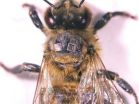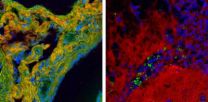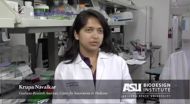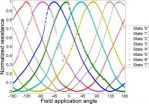Carlton Fire Complex, Washington -- July 22, 2014
2014-07-22
The Carlton Complex fires started on July 14, 2014, by lightning from a weather system that moved through the Methow Valley. The Carlton Complex consists of four fires: Stokes Fire, Gold Hikes Fire, French Creek Fire and the Cougar Flat. The Stokes and Gold Hikes fires are now one larger fire. The fires are burning in timber and grass and the area burning is currently over 243,000 acres in size. The present fire situation continues to rapidly change due to the high fire danger. Public and firefighter safety is the priority on the Carlton Complex fires. Thirty-five primary ...
African elephant genome suggests they are superior smellers
2014-07-22
July 22, 2014 – Sense of smell is critical for survival in many mammals. The ability to distinguish different odors, which is important for sniffing out food, avoiding predators, and finding mates, depends on the number and type olfactory receptors found in an organism's genome. In a study published today in Genome Research, researchers examined the olfactory receptor (OR) repertoire encoded in 13 mammalian species and found that African elephants have the largest number of OR genes ever characterized; more than twice that found in dogs, and five times more than in humans.
To ...
High-salt diet doubles threat of cardiovascular disease in people with diabetes
2014-07-22
Washington, DC -- People with Type 2 diabetes who eat a diet high in salt face twice the risk of developing cardiovascular disease as those who consume less sodium, according to a new study published in the Endocrine Society's Journal of Clinical Endocrinology & Metabolism.
Diabetes occurs when there is too much sugar in the bloodstream. People develop Type 2 diabetes when their bodies become resistant to the hormone insulin, which carries sugar from the blood to cells.
According to the U.S. Centers for Disease Control and Prevention, about 29.1 million Americans ...
Vitamin D deficiency raises risk of schizophrenia diagnosis
2014-07-22
Washington, DC -- Vitamin D-deficient individuals are twice as likely to be diagnosed with schizophrenia as people who have sufficient levels of the vitamin, according to a new study published in the Endocrine Society's Journal of Clinical Endocrinology & Metabolism.
Vitamin D helps the body absorb calcium and is needed for bone and muscle health. The skin naturally produces this vitamin after exposure to sunlight. People also obtain smaller amounts of the vitamin through foods, such as milk fortified with vitamin D. More than 1 billion people worldwide are estimated ...
New study reveals vulnerability of sharks as collateral damage in commercial fishing
2014-07-22
MIAMI –A new study that examined the survival rates of 12 different shark species when captured as
unintentional bycatch in commercial longline fishing operations found large differences in survival
rates across the 12 species, with bigeye thresher, dusky, and scalloped hammerhead being the most
vulnerable. The study, led by researchers at the University of Miami (UM) Rosenstiel School of
Marine and Atmospheric Science and UM Abess Center for Ecosystem Science and Policy, provides
new information to consider for future conservation measures for sharks in the Northwest ...
Are state Medicaid policies sentencing people with mental illnesses to prison?
2014-07-22
Researchers from the USC Schaeffer Center for Health Policy and Economics have linked tighter Medicaid policies governing antipsychotic drugs with increased incarceration rates for schizophrenic individuals.
The study comes amid media scrutiny over whether cutbacks in mental health actually save money, when other costs are taken into account.
Some health plans require an extra approval step before tests or treatments can be ordered for patients. This step – called prior authorization – is intended to encourage physicians to select cost-effective options by requiring ...
Should men at risk for cardiovascular disease receive earlier cholesterol treatment?
2014-07-22
New Rochelle, NY -- New guidelines on cholesterol treatment and cardiovascular risk assessment state that men have at least double the risk of dying from atherosclerotic cardiovascular disease or of having a heart attack or stroke as do women with a similar risk profile (based on age, smoking history, and cholesterol and blood pressure levels). The implications of this finding for when and how aggressively to treat high cholesterol are examined in an Editorial in Journal of Men's Health, a peer-reviewed publication from Mary Ann Liebert, Inc., publishers. The article is ...
Communication between nostril/skin microbiome bacteria can influence pathogen behavior
2014-07-22
CAMBRIDGE, Mass., July 22, 2014--A team of scientists has made an important discovery about the molecular interactions that occur between generally benign species of Propionibacterium bacteria and the pathogenic bacterium Staphylococcus aureus, the cause of most "staph" infections. These bacterial species are commonly found in the human nostrils and, also, on human skin. S. aureus is a potential pathogen that inhibits the nostrils of about a quarter of all adults. It is also a common cause of skin and more invasive infections. The team, led by Forsyth scientists, discovered ...
Research brings us nearer to understanding how neuro cells turn cancerous
2014-07-22
Scientists from the Sloan-Kettering Institute for Cancer Research in New York with the help of Plymouth University Peninsula Schools of Medicine and Dentistry have completed research which for the first time brings us nearer to understanding how some cells in the brain and nervous system become cancerous.
The results of their study are published in the prestigious journal Cancer Cell.
The research team led by Sloan-Kettering researchers studied a tumour suppressor called Merlin.
The results of the study have identified a new mechanism whereby Merlin suppresses ...
Retail pricing strategies: Do consumers prefer deep discounts or everyday low prices?
2014-07-22
Sometimes finding the best bang for your buck feels like a wild goose chase. It's hard to know which stores offer the best prices at any given time. According to a new study in the Journal of Consumer Research, when trying to maximize savings, consumers will choose retailers they believe offer the lowest prices the majority of the time.
"We looked at the impact different pricing strategies have on the stores people shop at when they do not know the product prices unless they visit the store," write authors Shai Danziger (Tel Aviv University), Liat Hadar (IDC Herzliya), ...
Avoiding buyer's remorse: Is product satisfaction higher when consumers are flush?
2014-07-22
It's the last day of the month and your paycheck arrives tomorrow. You buy a new pair of shoes but have a nagging feeling your money could have been better spent. According to a new study in the Journal of Consumer Research, consumers are less satisfied with what they have purchased with their bottom dollar compared to when they have money in the bank.
"As someone spends money, parting with one's remaining funds makes a product feel more costly and causes consumers to be less satisfied with what they buy," write authors Robin L. Soster (University of Arkansas), Andrew ...
Report on viruses looks beyond disease
2014-07-22
In contrast to their negative reputation as disease causing agents, some viruses can perform crucial biological and evolutionary functions that help to shape the world we live in today, according to a new report by the American Academy of Microbiology.
"Viruses participate in essential Earth processes and influence all life forms on the planet, from contributing to biogeochemical cycles, shaping the atmospheric composition, and driving major speciation events," states Marilyn Roossinck of Pennsylvania State University, a member of the steering committee that helped to ...
Radio frequency ID tags on honey bees reveal hive dynamics
2014-07-22
CHAMPAIGN, Ill. — Scientists attached radio-frequency identification (RFID) tags to hundreds of individual honey bees and tracked them for several weeks. The effort yielded two discoveries: Some foraging bees are much busier than others; and if those busy bees disappear, others will take their place.
The findings are reported in the journal Animal Behaviour.
Tagging the bees revealed that about 20 percent of the foraging bees in a hive brought home more than half of the nectar and pollen gathered to feed the hive.
"We found that some bees are working very, very hard ...
Vanderbilt study shows therapeutic bacteria prevent obesity in mice
2014-07-22
A probiotic that prevents obesity could be on the horizon. Bacteria that produce a therapeutic compound in the gut inhibit weight gain, insulin resistance and other adverse effects of a high-fat diet in mice, Vanderbilt University investigators have discovered.
"Of course it's hard to speculate from mouse to human," said senior investigator Sean Davies, Ph.D., assistant professor of Pharmacology. "But essentially we've prevented most of the negative consequences of obesity in mice, even though they're eating a high-fat diet."
Regulatory issues must be addressed before ...
Enhanced NIST instrument enables high-speed chemical imaging of tissues
2014-07-22
A research team from the National Institute of Standards and Technology (NIST), working with the Cleveland Clinic, has demonstrated a dramatically improved technique for analyzing biological cells and tissues based on characteristic molecular vibration "signatures." The new NIST technique is an advanced form of the widely used spontaneous Raman spectroscopy, but one that delivers signals that are 10,000 times stronger than obtained from spontaneous Raman scattering, and 100 times stronger than obtained from comparable "coherent Raman" instruments, and uses a much larger ...
NASA's TRMM satellite measures up Super Typhoon Rammasun
2014-07-22
NASA's TRMM satellite measured up Super Typhoon Rammasun's rainfall rates, rainfall totals and cloud heights providing a look at the inner workings and aftermath of the storm.
Super Typhoon Rammasun struck the southern coast of China on Friday, July 18 as a very powerful super typhoon with sustained winds estimated at 135 knots (~155 mph or equivalent to a Category 5 hurricane on the US Saffir-Simpson scale), making it the strongest typhoon to hit the area in several decades.
Rammasun made landfall at 3:30 p.m. (local time) on Hainan Island where the southern half of ...
Preschoolers can reflect on what they don't know
2014-07-22
Contrary to previous assumptions, researchers find that preschoolers are able to gauge the strength of their memories and make decisions based on their self-assessments. The study findings are published in Psychological Science, a journal of the Association for Psychological Science.
"Previously, developmental researchers assumed that preschoolers did not introspect much on their mental states, and were not able to reflect on their own uncertainty when problem solving," says psychological scientist Emily Hembacher of the University of California, Davis, lead author of ...
Extra exercise helps depressed smokers kick the habit faster
2014-07-22
This news release is available in French. Montreal, July 22, 2014 — People diagnosed with depression need to step out for a cigarette twice as often as smokers who are not dealing with a mood disorder. And those who have the hardest time shaking off the habit may have more mental health issues than they are actually aware of.
Those insights were among the collective findings recently published in the journal Nicotine & Tobacco Research by a team of researchers based in part at Concordia University.
While nearly one in five North American adults are regular smokers, ...
CEOs who motivate with 'fightin' words' shoot themselves in the foot
2014-07-22
Heading into the war room to fire up the troops? Declaring war on the competition to boost sales? Well, CEO, you might want to tamp down them's fightin' words—you could be shooting yourself in the foot.
A new Brigham Young University business study finds that bosses who try to motivate their employees with violent rhetoric—think of Steve Jobs declaring "thermonuclear war" on Samsung—end up motivating rival employees to play dirty.
"Business executives use violent language all the time," said David Wood, BYU professor of accounting and one of two BYU authors on the paper. ...
Dangers of desert dust: New diagnostic tool for valley fever
2014-07-22
VIDEO:
In this video, biodesign researcher Krupa Navalkar describes a new diagnostic technique for pinpointing Valley Fever.
Click here for more information.
On July 5, 2011, a massive wall of dust, ("haboob," in Arabic), blanketed Phoenix, Arizona, creating an awesome spectacle, (or stubborn nuisance, depending on your perspective). Dust storms are a common occurrence in the arid desert environments of the American Southwest.
But windborne dust can be a serious health risk, ...
A new multi-bit 'spin' for MRAM storage
2014-07-22
WASHINGTON D.C., June 22, 2014 -- Interest in magnetic random access memory (MRAM) is escalating, thanks to demand for fast, low-cost, nonvolatile, low-consumption, secure memory devices. MRAM, which relies on manipulating the magnetization of materials for data storage rather than electronic charges, boasts all of these advantages as an emerging technology, but so far it hasn't been able to match flash memory in terms of storage density.
In the journal Applied Physics Letters, from AIP Publishing, a France-U.S. research team reports an intriguing new multi-bit MRAM storage ...
Fly-inspired sound detector
2014-07-22
WASHINGTON D.C., June 22, 2014 – Even within a phylum so full of mean little creatures, the yellow-colored Ormia ochracea fly is distinguished among other arthropods for its cruelty -- at least to crickets. Native to the southeastern U.S. states and Central America, the fly is a most predatory sort of parasite. It swoops onto the back of a singing male cricket, deposits a smear of larvae, and leaves its wicked brood to invade, kill and consume the cricket from inside out.
None of this would be possible without the fly's ability to find a cricket -- the cornerstone of ...
Law of physics governs airplane evolution
2014-07-22
DURHAM, N.C. -- Researchers believe they now know why the supersonic trans-Atlantic Concorde aircraft went the way of the dodo -- it hit an evolutionary cul-de-sac.
In a new study, Adrian Bejan, professor of mechanical engineering and materials science at Duke University, shows that a law of physics he penned more than two decades ago helps explain the evolution of passenger airplanes from the small, propeller-driven DC-3s of yore to today's behemoth Boeing 787s. The analysis also provides insights into how aerospace companies can develop successful future designs.
The ...
The evolution of airplanes
2014-07-22
WASHINGTON D.C. July 22, 2014 -- One of the traditional arguments against Darwinian evolution has been that no one can confirm the process exists because it occurs on a time scale immensely greater than a human lifetime. Adrian Bejan, the J. A. Jones Distinguished Professor of Mechanical Engineering at Duke University, has disagreed with that notion ever since 1996 when he discovered the Constructal Law, a fundamental principle of physics that underlies the evolution of flow systems as they change in design over time.
In a new paper in the Journal of Applied Physics, ...
Bats use polarized light to navigate
2014-07-22
Scientists have discovered that greater mouse-eared bats use polarisation patterns in the sky to navigate – the first mammal that's known to do this.
The bats use the way the Sun's light is scattered in the atmosphere at sunset to calibrate their internal magnetic compass, which helps them to fly in the right direction, a study published in Nature Communications has shown.
Despite this breakthrough, researchers have no idea how they manage to detect polarised light.
'We know that other animals use polarisation patterns in the sky, and we have at least some idea ...
[1] ... [3339]
[3340]
[3341]
[3342]
[3343]
[3344]
[3345]
[3346]
3347
[3348]
[3349]
[3350]
[3351]
[3352]
[3353]
[3354]
[3355]
... [8702]
Press-News.org - Free Press Release Distribution service.











